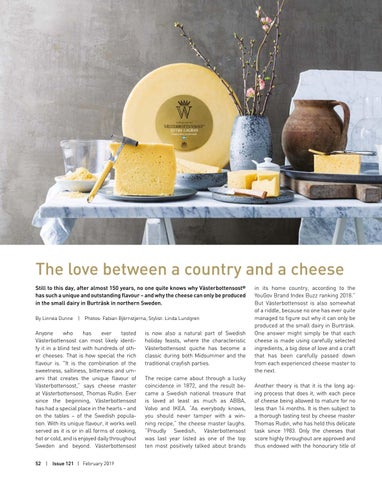Scan Magazine | Special Theme | A Taste of Sweden
The love between a country and a cheese Still to this day, after almost 150 years, no one quite knows why Västerbottensost® has such a unique and outstanding flavour – and why the cheese can only be produced in the small dairy in Burträsk in northern Sweden. By Linnea Dunne | Photos: Fabian Björnstjerna, Stylist: Linda Lundgren
Anyone who has ever tasted Västerbottensost can most likely identify it in a blind test with hundreds of other cheeses. That is how special the rich flavour is. "It is the combination of the sweetness, saltiness, bitterness and umami that creates the unique flavour of Västerbottensost,” says cheese master at Västerbottensost, Thomas Rudin. Ever since the beginning, Västerbottensost has had a special place in the hearts – and on the tables – of the Swedish population. With its unique flavour, it works well served as it is or in all forms of cooking, hot or cold, and is enjoyed daily throughout Sweden and beyond. Västerbottensost 52 | Issue 121 | February 2019
is now also a natural part of Swedish holiday feasts, where the characteristic Västerbottensost quiche has become a classic during both Midsummer and the traditional crayfish parties. The recipe came about through a lucky coincidence in 1872, and the result became a Swedish national treasure that is loved at least as much as ABBA, Volvo and IKEA. “As everybody knows, you should never tamper with a winning recipe,” the cheese master laughs. “Proudly Swedish, Västerbottensost was last year listed as one of the top ten most positively talked about brands
in its home country, according to the YouGov Brand Index Buzz ranking 2018.” But Västerbottensost is also somewhat of a riddle, because no one has ever quite managed to figure out why it can only be produced at the small dairy in Burträsk. One answer might simply be that each cheese is made using carefully selected ingredients, a big dose of love and a craft that has been carefully passed down from each experienced cheese master to the next. Another theory is that it is the long aging process that does it, with each piece of cheese being allowed to mature for no less than 14 months. It is then subject to a thorough tasting test by cheese master Thomas Rudin, who has held this delicate task since 1983. Only the cheeses that score highly throughout are approved and thus endowed with the honourary title of
